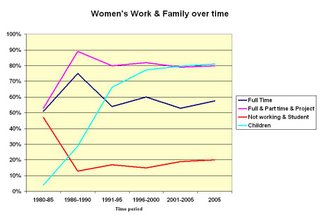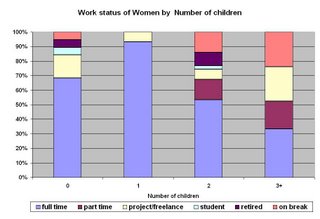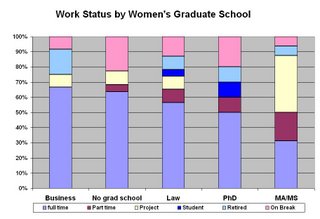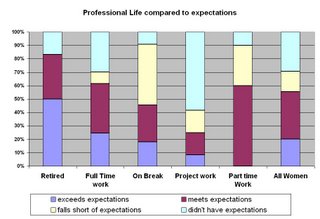|
Web Exclusives: PawPlus Want to share your experiences and opinions about your professional journeys and work and family issues? Click here for a blog created by Cynthia King Vance '80, the author of this research. You can add your comments by clicking on “comments” at the bottom of a posting. Choices and Circumstances: By Cynthia King Vance '80 With data analysis by Emily Moidudden GS The Class of 1980 used the occasion of our 25th reunion to explore career choices and experiences though our reunion survey. Conversations among ourselves, as well as in the media, had surfaced issues about the number of highly trained women who were not working or had cut back, about whether they opted or were squeezed out, and about the illusive quest of many for balance between work and family – or at least a better way to juggle. Many stories seemed anecdotal, and the class survey provided an opportunity to get some data points. About 300 classmates responded, and the proportion of men and women was reflective of the class. The following observations reflect the feedback of these respondents.
While many fewer women than men were working full time, most of the women in the Class of 1980 were working. Eighty percent of the women in the class reported working for pay, with 58 percent working full time at the time of the survey and another 22 percent working for pay on a part-time, project, or freelance basis. This compares to 98 percent of the male graduates of the class working for pay, with 89 percent working full time. Women have embraced non-traditional jobs. Ten percent were working part time, and another 12 percent on a project or freelance basis. These are options that women have pursued much more than men, with hardly any men (less than 1 percent) working part time. Men working on a project or freelance basis worked 34 hours per week. These alternative work structures seem to meet a need to gain flexibility, generate income, or stay engaged professionally when full time doesn't work. To some extent, women probably have created these work options to meet their needs. Most of the women who were not working expect to return to work. Twenty percent of the class's women were not working. Only a third of them considered themselves “retired,” rather than a student or on a career break. The top reasons for the current break were the need for flexibility and child-care demands. Almost all expected to return to work within the next 10 years, with many planning to return much sooner. Even in the highest-earning households, as many women considered themselves on a career break as retired. The women who were not currently working spent an average of 15 hours per week on volunteer activities, compared to three hours per week for full-time workers and 7 hours per week for those working part time or on a project basis. Women and men's paths diverged 10 to 15 years after graduation. The survey looked at choices over time. Almost 80 percent of both men and women in the class went to graduate school, most in the five years after graduation from Princeton. Seventy-five percent of women classmates, and 81 percent of the men, worked full time in the five to 10 years after graduation. This participation rate then plummeted to 54 percent of the class's women between 10 and 15 years after graduation, while men's rate of fulltime work climbed to 83 percent. At this point 10 percent of the women were not working, 16 percent were working part time, and 10 percent were working on a freelance basis. There seemed to be a flurry of re-entry activity between 15 and 20 years out, when the percentage of women working full time rose to 60 percent, but then it returned to 53 percent in the next five-year period, while men's rate of full time work stayed fairly constant at about 85 percent. It seems likely that many women have been in and out of various work situations, rather than permanently in one category or another. Not surprisingly, the decline in the numbers of women working coincided with raising children. By the 15th reunion, when work rates had dropped, almost 66 percent of the women in the class had children. More than 81 percent of the women in the class were raising at least one child by the 25th reunion.
... And the number of children makes a big difference. Ninety-three percent of those with one child (15 percent of the women) were working full time at the time of the survey, which was a greater percentage than any other group (and a higher rate than their male classmates). The proportion of alumnae working full time declined in step with the number of additional children: 53 percent of mothers with two children (43 percent of the women) and about a third of mothers with three or more children (22 percent of the class) worked full time. Looked at another way however, most (77 percent) of the women working full time are mothers, juggling furiously. Note: The survey did not probe whether full-time workers had “dialed down” full-time work. Men are more likely to work full time as they have more children. Opting out or cutting back was not limited to mothers. What was perhaps surprising was the experience of women who did not have children (19 percent of the women). Only 68 percent of them were working full time, a lower rate than women with one child. Another 16 percent work on projects. Why weren't more of them engaged in full-time work, at the same rate as their male classmates? Did they achieve their goals, find a new passion, run into the glass ceiling, or experience some other disincentive?
Certain career choices or fields may have been better for achieving either sustainable careers or flexible work. In this sample of women, all of the M.D.s were working either full (71 percent) or part (29 percent) time. Three-quarters of the female lawyers and M.B.A.'s were working, with 67 percent of the M.B.A.'s and 57 percent of the lawyers working full time. About the same proportion of female lawyers and M.B.A.'s worked on a project basis (9 and 8 percent, respectively); 9 percent of the lawyers worked part time, but none of the MBAs. The Ph.D.'s were the least likely to be in paid work, with 50 percent working full time and 10 percent part time. Those with other master's degrees were the most likely to be working for pay (88 percent), with most of them working part time (19 percent) or on a project basis (38 percent). Of those who did not get another degree after Princeton, 64 percent were working full time, 5 percent part time and 9 percent freelance. It would be interesting to explore whether these outcomes reflect career opportunities, flexible options in different fields, or something about the women themselves – as well as whether changes in the workplace will lead to different outcomes for subsequent generations of women making these choices. (Note: the breakdown of graduate schools choices for alumnae were: none 22 percent, law 23 percent, M.A./M.S. 16 percent, business 12 percent, medicine (7 percent), Ph.D (10 percent). Earnings outcomes differed from expectations, which were more egalitarian. Sixty-three percent of the class reported that they expected that each partner would make a substantial contribution to the financial pot when they married (or the equivalent). Most (57 percent) of the classmates in a relationship ended up with the opposite situation – a relationship with a dominant breadwinner. Sixty percent of the men in the class were the major breadwinner in their family. Almost 25 percent of the women in the class generate “a bit” or none of their family's income. However, almost a quarter of the married (or equivalent) women in the class reported being the breadwinner in their family, and more women than men (51 percent vs. 39 percent) were in families where both partners make a substantial contribution to the household's income. Class of 1980 women faced several pressures and experiences that could have shaped a decision to leave the traditional career path: Women had more disruptions to their careers, perhaps making it more difficult to “stay on track.” In every five-year time period after 1990 (i.e., after the 10th reunion), women reported more career disruptions than men. More than 20 percent of the women experienced what they considered to be a “major” career break in each of these time periods, which was two to three times the rate for men. As alluded to earlier, the period between the 10th and the 15th reunions was a period of change for a large number of women in the class – with almost 30 percent reporting a major career disruption and another 15 percent having a minor break. Women experienced slightly more job changes since graduation – 3.6 times, compared to 3.3 times for men. (Note: 20 percent of the class has changed jobs six or more times since graduation.) Working full time is highly time-consuming. The average 1980 Princetonian working full time worked 52 hours per week (excluding commuting), with men working about 2 hours a week longer than women. We can't tell from this data whether men are in more demanding (and presumably lucrative) jobs or women are just more efficient. Of classmates working over 40 hours per week, 22% worked 60-69 hours and 9% more worked 70 or more hours per week.
Women in the class do more of “the second shift.” The full-time working women of the Class of 1980 spend 1.4 more hours per week on housework and 6.1 more hours on childcare and family commitments than their male classmates working full time. Despite variations in work commitments, full-time, part-time and project-based working women seem to spend about the same amount of time on child care and family commitments (between 25 and 29 hours per week). Women on career break spend about 45 hours per week taking care of their family. The work environment hasn't always been encouraging. Fifty-four percent of women in the class, compared to 12 percent of men, reported experiencing harassment or discrimination in the workplace, most of which they considered gender-related.
Class members seem mostly satisfied with these outcomes. Of those classmates who had expectations upon graduation, more than 80 percent reported that their personal lives met or exceeded those expectations and more than 75 percent reported that their professional life met or exceeded their expectations. Satisfaction with their professional outcome varied for women depending on their work situation – with those who were retired not surprisingly the most satisfied, and full time workers more satisfied than others. Almost 30 percent of the class said that they did not have professional expectations when they graduated and about 15 percent did not have personal expectations. When asked what they wish they had done differently, classmates focused on children – 21 percent of women wish they had more kids (as do 14 percent of the men) and 22 percent of men wish they had had children earlier (but only 13 percent of women feel this way). An equal number of men and women (16 percent) wish they had chosen a different profession. (Note: only 1 percent of classmates reported that they wished they had had less children, or children later). Background on other aspects of members of the Class of 1980 as of their 25th reunion: 82 percent of the women and 87 percent of the men were married, with an average relationship of about 17 years. More than 20 percent of the women (and 8 percent of men) in the class met their partner at Princeton. Women and men were about equally likely to be single (13 percent of men and 15 percent of women at their 25th reunion). Men are more likely to be raising children (87 percent vs. 81 percent of women) and to have more of them if they do (2.5 vs. 2.1 on average). The children of the Class of 1980 ranged in age from newborn to over 21, but most were between the ages of 9 and 17. Almost 80 percent of classmates of both sexes went to graduate school after Princeton. Women were less likely to go to professional schools (43 percent of the women, compared to 56 percent of the men), while a higher proportion of women received other masters degrees or Ph.D.'s after Princeton (32 percent of women and 22 percent of men). The survey confirms that women have taken many different paths and that there are a substantial number of classmates in every category of choice and circumstance. But the results also prompt as many questions as they answer: Does this picture look the same for other Princeton classes of the same era and for peers at other elite universities? Does it look the same for women before and after us, or are work environments and/or women's decisions changing the patterns? What will the women in the Class of 1980 do next? Will they continue to expand the numbers of part-time and freelance workers (and push for these jobs to be adequately compensated)? Will they return to, or increase their time on, more demanding paid work when their teenagers leave home over the next few years? What will the financial outcomes be for women, and will there be long-term negative consequences for lower-workforce participation? How can younger women learn from this experience? Will knowing more about the timing and outcomes enable them to better prepare, manage, and weather the career disruptions that are still likely to affect them? The generations of Princeton alumnae can be a unique resource
and support network for each other as we tackle these decisions
and transitions. Emily Moidudden is a doctoral student at the Woodrow Wilson School and the Office of Population Research.
|





